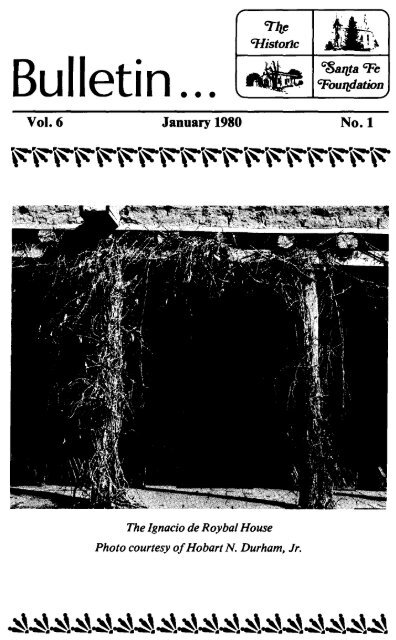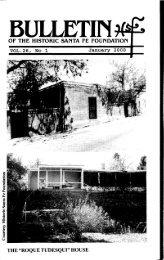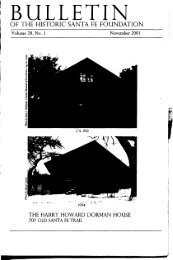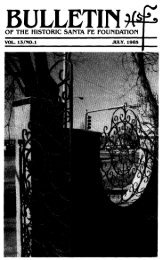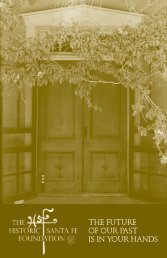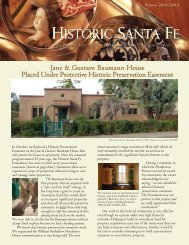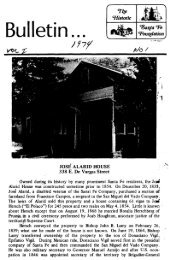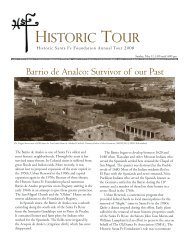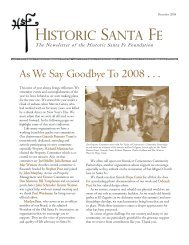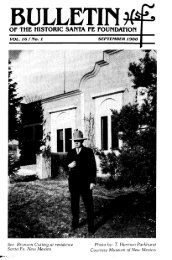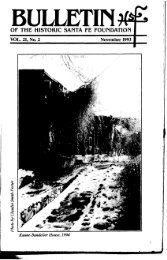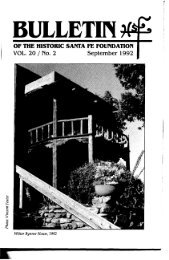Ignacio de Roybal House - Historic Santa Fe Foundation
Ignacio de Roybal House - Historic Santa Fe Foundation
Ignacio de Roybal House - Historic Santa Fe Foundation
Create successful ePaper yourself
Turn your PDF publications into a flip-book with our unique Google optimized e-Paper software.
•<br />
~a'l.ta<br />
Wistol1c<br />
Bulletin ...<br />
crl1.e<br />
~ou'l.dation<br />
J&!<br />
.~l·~ .. , ~e ~~<br />
Vol. 6 January 1980 No.1<br />
The <strong>Ignacio</strong> <strong>de</strong> <strong>Roybal</strong> <strong>House</strong><br />
Photo courtesy of Hobart N. Durham, Jr.
THE IGNACIO DE ROYBAL HOUSE<br />
One of the ol<strong>de</strong>st resi<strong>de</strong>nces in the Pojoaque Valley, the <strong>Ignacio</strong> <strong>de</strong><br />
<strong>Roybal</strong> <strong>House</strong> is an excellent example of New Mexico's traditional Spanish<br />
Colonial architectural style. Situated south of the Rio Nambe at the<br />
southest corner of Jacona plaza, it is a one-story, flat-roofed adobe structure<br />
with a tee-shaped floor plan. Although the plaza has been changed<br />
somewhat in recent years by the construction of the El Rancho road, the<br />
<strong>Roybal</strong> property has retained the atmosphere of the 18th century when it<br />
was the headquarters of a large hacienda. Set back from the road behind a<br />
low adobe wall, the house is sha<strong>de</strong>d by huge willows and cottonwoods<br />
watered from an historic acequia which has irrigated valley farmlands for<br />
centuries. Spanish land conveyances show a dwelling on this location in the<br />
mid-1750s but its nucleus may date from 1705 when Don <strong>Ignacio</strong> <strong>de</strong> <strong>Roybal</strong><br />
y Torrado purchased the land where it stands to augment his adjoining<br />
holdings. Because the same records indicate a much larger building in the<br />
18th century, it is now believed that the present Trujillo resi<strong>de</strong>nce, immediately<br />
to the north, was once connected to it, probably by a zaguan. A<br />
veteran of the Vargas re-conquest of 1693, <strong>Roybal</strong> was the progenitor of a<br />
large and important <strong>Santa</strong> <strong>Fe</strong> area family whose <strong>de</strong>scendants retained<br />
possession of the house until recent times. Now owned by Mr. and Mrs.<br />
Robert A. Fisher the <strong>Roybal</strong> resi<strong>de</strong>nce is significant both architecturally<br />
and historically, an important remin<strong>de</strong>r of an earlier era.<br />
Ma<strong>de</strong> of varying thicknesses of multi-layered adobe bricks the house<br />
walls are covered by the traditional layer of soft plaster reinforced with bits<br />
of straw. To drain the roof, long canales protru<strong>de</strong> just below the firewall<br />
extending well away from the building to prevent erosion of the walls and<br />
foundation. On the west a portal braced by log pillars and corbels shelters<br />
the kitchen, the living room (sala) and study which are arranged in tan<strong>de</strong>m.<br />
The formal entrance consists of a pair of elegant paneled doors with heavy<br />
iron hardware which open into the sala but everyday access is through a<br />
small glass and wood door into the kitchen. Separated by a small hallway<br />
and bath, the dining room and master bedroom extend westward at right<br />
angles from the kitchen to form the short leg of the tee. A second bedroom<br />
of more recent construction has been ad<strong>de</strong>d north of the kitchen. All doors<br />
and windows are topped by pedimented lintels characteristic of New<br />
Mexico's Territorial style. Heavy vigas support the ceilings which are ma<strong>de</strong><br />
of split cedar latiflas in the west wing and of pine boards in the sala. Heated<br />
by two small Pueblo fireplaces this room also has a pegged pine floor.<br />
Deep reveals enclose the doors and windows to accommodate the sash and<br />
trim to the massive walls.<br />
A native of Galicia in northwestern Spain, <strong>Ignacio</strong> <strong>de</strong> <strong>Roybal</strong> was born<br />
C. 1673 at Caldas <strong>de</strong> Reyes, a village near the famous shrine of Santiago <strong>de</strong><br />
Campostela. He was probably one of a group of soldiers recruited in the<br />
area by Don Diego <strong>de</strong> Vargas to participate in the Reconquest. Early in<br />
1694, soon after the capture of <strong>Santa</strong> <strong>Fe</strong>, <strong>Roybal</strong> married Francisca Gomez<br />
Robledo, a member of a powerful but controversial 17th century New<br />
Mexico family. In the mid-l600s Francisca's uncle Francisco Gomez<br />
Robledo, her father Andres and other relations were accused by enemies of
Photo courtesy of Hobart N. Durham, Jr.<br />
"Judaical ten<strong>de</strong>ncies." During the trial conducted in Mexico City by officials<br />
of the Holy Office or Inquisition it was alleged that Francisco actually<br />
had a little tail, an abnormality which must surely signify inherent<br />
evil. Despite this damaging statement he was eventually able to disprove all<br />
charges and clear the family name but in later years the Gomez Robledos<br />
were often known as "Los Colitas." Although Francisca's father was<br />
killed at <strong>Santa</strong> <strong>Fe</strong> in the first days of the 1680 revolt, his daughters were the<br />
only members of this extensive clan to return to New Mexico with <strong>de</strong><br />
Vargas.<br />
Following his marriage <strong>Ignacio</strong> <strong>de</strong> <strong>Roybal</strong> assumed command of a<br />
military <strong>de</strong>tachment charged with the surveillance of the Tano and Tewa<br />
pueblos north of <strong>Santa</strong> <strong>Fe</strong>. Still unreconciled to Spanish rule these Indians<br />
were among those who rose again in 1696 during the Pueblos' final attempt<br />
at in<strong>de</strong>pen<strong>de</strong>nce. As a reward for his services in this campaign Governor<br />
Pedro Rodriguez Cubero awar<strong>de</strong>d a grant of land to <strong>Roybal</strong> in <strong>Santa</strong> <strong>Fe</strong><br />
near the present site of Sena Plaza. At about the same time his brother-inlaw<br />
Captain Jacinto Pelaez received a large tract north of the capital near<br />
the Pueblo of Jacona which had been abandoned during the hostilities.<br />
<strong>Roybal</strong> purchased part of this property from Pelaez and after the latter's<br />
<strong>de</strong>ath, applied to governmental authorities for the rest of the Jacona grant<br />
which was conveyed to him in 1702. Three years later he further enlarged<br />
his holdings by buying 1Y2 fanegas of adjoining farm land, part of another<br />
small grant which Cubero had ma<strong>de</strong> to Juan <strong>de</strong> Mestas. According to
documents from the settlement of <strong>Roybal</strong>'s estate he tra<strong>de</strong>d "a good<br />
travelling horse" (un caballo <strong>de</strong> camino bueno) for the Mestas lands which<br />
exten<strong>de</strong>d to the Rio Cuyamungue. Although his title was later questioned<br />
by the Pueblo of Pojoaque, it was on this part of the Jacona rancho that<br />
Don <strong>Ignacio</strong> and Dona Francisca maintained their resi<strong>de</strong>nce and raised<br />
their family of nine children.<br />
One of New Mexico's leading citizens during the first half of the 18th<br />
century <strong>Roybal</strong> held municipal offices in <strong>Santa</strong> <strong>Fe</strong> and served as High<br />
Sheriff of the Inquisition <strong>de</strong>spite the earlier problems of his wife's<br />
relatives. He was also a member of La Conquistadora Confraternity to<br />
which he ma<strong>de</strong> occasional contributions including elk and buffalo hi<strong>de</strong>s<br />
and other useful items. His el<strong>de</strong>st son, Santiago <strong>de</strong> <strong>Roybal</strong>, was educated in<br />
Mexico City where he prepared for the priesthood. After he returned to<br />
<strong>Santa</strong> <strong>Fe</strong> in 1730, the first native New Mexican to be ordained, he served as<br />
the personal representative of the Bishop of Durango with the title of<br />
Vicario y Juez Eclesiatico (Vicar and Ecclesiastical Judge). Following his<br />
father's <strong>de</strong>ath Santiago was responsible for the administration of the estate<br />
which inclu<strong>de</strong>d large numbers of livestock in addition to his real estate,<br />
weapons and personal belongings. Enumerated in the inventory were 200<br />
head of beef cattle and 350 sheep and goats loaned at interest on partido<br />
for 300/0of the wool, lambs and kids produced annually. There were also a<br />
band of mares running near <strong>Santa</strong> Cruz <strong>de</strong> la Canada and a number of<br />
oxen in the possession of <strong>Ignacio</strong>'s sons. Evaluation of his estate indicated<br />
that the young soldier from Galicia had become wealthy during his 60 years<br />
in New Mexico.<br />
In 1707, when <strong>Roybal</strong> was first establishing himself at Jacona, the adjoining<br />
Pueblo of Pojoaque, also abandoned in 1696, was reoccupied by<br />
member families who had been living in other Tewa pueblos or with hostile<br />
tribes. It then became evi<strong>de</strong>nt that the property which <strong>Roybal</strong> had purchased<br />
from Mestas was in fact an encroachment on the recognized foursquare<br />
leagues of Pojoaque lands. The matter remained in abeyance for<br />
over two centuries. In 1864, patent to a short four-square league "grant"<br />
was given to the Pueblo of Pojoaque which inclu<strong>de</strong>d the <strong>Roybal</strong> property.<br />
About 1912 a speculative land company hea<strong>de</strong>d by D.C. Collier began<br />
acquiring both warranty and quit claim <strong>de</strong>eds to lands near Jacona from<br />
<strong>de</strong>scendants of the original Spanish settlers and from the few remaining<br />
Pojoaque Indians who had moved from the area. The following year<br />
(1913) in the case of "U.S. vs Sandoval" the <strong>Fe</strong><strong>de</strong>ral Supreme Court<br />
finally <strong>de</strong>termined that the Pueblo Indians, who had formerly been consi<strong>de</strong>red<br />
as citizens who could alienate their lands, were wards of the government.<br />
In an attempt to quiet title to pueblo lands which had been secured<br />
by non-Indians, the Pueblo Lands Board was created by Congress in 1924<br />
to <strong>de</strong>termine Indian title in each pueblo. Several Pojoaque families living in<br />
the Pueblo of Nambe claimed the grant, and the Collier title was challenged<br />
in fe<strong>de</strong>ral court. The grant was reactivated but because of the long<br />
possession of the <strong>Roybal</strong> lands, pueblo title to them was <strong>de</strong>clared extinguished.<br />
The <strong>Roybal</strong> and Trujillo families and their relatives continued<br />
to hold their properties by right of adverse possession, as they had for 200<br />
years. On November 24, 1937 a patent was granted to Porfirio <strong>Roybal</strong> by<br />
the U.S. government for the property now owned by Mr. and Mrs. Fisher.
Photo courtesy of Hobart N. Durham, Jr.<br />
Two years ago the <strong>Ignacio</strong> <strong>de</strong> <strong>Roybal</strong> <strong>House</strong> was placed on the New Mexico<br />
State Register of Cultural Properties in recognition of its historic<br />
importance.<br />
Sources<br />
Documents concerning <strong>Ignacio</strong> <strong>de</strong> <strong>Roybal</strong> estate in possession of Mr. and Mrs. Robert A.<br />
Fisher, Jacona, New Mexico.<br />
Spanish Archives of New Mexico I, #735, 745, 1136 and 1261.<br />
Records of Private Land Claims Adjudicated by the V.S. Surveyor General, #92.<br />
Records of Private Land Claims Adjudicated by the V.S. Court of Private Land Claims, #35<br />
and 237.<br />
Chavez, Fray Angelico, "EI Vicario Don Santiago <strong>Roybal</strong>," E/ Pa/cio, Vol. 55, No.8,<br />
August, 1948.<br />
____ . New Mexico Families. <strong>Santa</strong> <strong>Fe</strong>, 1954.<br />
____ . Our Lady of the Conquest. Albuquerque, 1948.<br />
John O. Baxter<br />
October 18, 1979
Two Canyon Road Homes <strong>Fe</strong>atured<br />
at <strong>Foundation</strong> Open <strong>House</strong><br />
On August 26, 1979, the <strong>Historic</strong> <strong>Santa</strong> <strong>Fe</strong> <strong>Foundation</strong> held an open<br />
house at two historic homes located on Canyon Road, the Juan Jose Prada<br />
<strong>House</strong> at 519 Canyon Road and its neighbor, EI Zaguan. More than 150<br />
members and their guests came to tour the houses, which were open from<br />
1:00 to 5:00 p.m., and to enjoy the lemona<strong>de</strong> served on the west porch of<br />
EI Zaguan, overlooking the Adolph Ban<strong>de</strong>lier gar<strong>de</strong>n.<br />
The open house was planned as a part of the <strong>Foundation</strong>'s continuing<br />
program to give members the opportunity of seeing some of the city's<br />
historic buildings not normally open to the public.<br />
Renew Your Membership!<br />
The <strong>Historic</strong> <strong>Santa</strong> <strong>Fe</strong> <strong>Foundation</strong> was foun<strong>de</strong>d in 1961 for the purpose<br />
of preserving sites, buildings and objects significant in the history and<br />
culture of <strong>Santa</strong> <strong>Fe</strong> and New Mexico, and of educating the interested public<br />
in their historical and architectural significance. The <strong>Foundation</strong> <strong>de</strong>pends<br />
on its members to carry out these objectives of preservation and education<br />
- please remember to renew your membership for 1980.<br />
Annual Membership Dues:<br />
Individual $5.00<br />
Husband and Wife $7.50<br />
Commercial $10.00<br />
Sustaining $50.00<br />
Life $1,000.00<br />
Please send dues to The <strong>Historic</strong> <strong>Santa</strong> <strong>Fe</strong> <strong>Foundation</strong>, P.O. Box 2535,<br />
<strong>Santa</strong> <strong>Fe</strong>, New Mexico, or stop by the <strong>Foundation</strong>'s office in the rear of the<br />
Tully <strong>House</strong> located at the intersection of Grant and Griffin Streets, 9:00<br />
to 1:00 weekday mornings. Membership dues are income tax <strong>de</strong>ductible.<br />
Terms to Know in <strong>Historic</strong> <strong>Santa</strong> <strong>Fe</strong><br />
santo: Image of a saint<br />
camino: Road<br />
zaguan: Roofed space joining separate buildings or rooms<br />
parroquia: A parish church as distinguished from a mission<br />
co/radia: Confraternity; local church society approved by a bishop<br />
Old <strong>Santa</strong> <strong>Fe</strong> Today<br />
University of New Mexico Press<br />
and The <strong>Historic</strong> <strong>Santa</strong> <strong>Fe</strong> <strong>Foundation</strong>
Sister Carl ann Retires as Chapel Manager<br />
A farewell dinner was held for Sister Carlann Herman at The Inn at<br />
Loretto on September 18, 1979, jointly sponsored by the Inn and The<br />
<strong>Historic</strong> <strong>Santa</strong> <strong>Fe</strong> <strong>Foundation</strong>. The dinner marked Sister Carlann's retirement<br />
as manager of the Loretto Chapel, a position she held for thirteen<br />
years, and was atten<strong>de</strong>d by many of Sister Carlann's family and friends,<br />
along with volunteers of the <strong>Foundation</strong> who have worked at the Chapel<br />
and other representatives of both the Inn and the <strong>Foundation</strong>.<br />
A native of Las Vegas, New Mexico, Sister Carlann joined the Sisters of<br />
Loretto in 1930. She spent many of the next 35 years working at Webster<br />
College in St. Louis, Missouri, coming back to <strong>Santa</strong> <strong>Fe</strong> in 1966. Following<br />
her retirement from the Chapel in September, Sister Carlann returned to<br />
work with the community of the Sisters of Loretto in St. Louis.<br />
Sister Rita Marie Romero has succee<strong>de</strong>d to the position of manager of<br />
the Loretto Chapel. Sister Rita Marie worked with Sister Carlann for many<br />
years and celebrated her fiftieth year with the Or<strong>de</strong>r of the Sisters of<br />
Loretto in 1977.<br />
<strong>Historic</strong> <strong>Santa</strong> <strong>Fe</strong> <strong>Foundation</strong><br />
Annual Meeting<br />
Date: Monday, January 14, 1980<br />
Time: 8:00 p.m.<br />
Place: Sweeney Convention Center, Room 6<br />
Program: After a brief business meeting, Dr. Myra Ellen Jenkins will present<br />
a program entitled "John Gaw Meem - Citizen of <strong>Santa</strong><br />
<strong>Fe</strong>."


